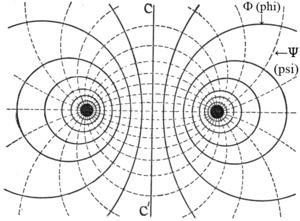
Does an Electron ‘particle’ exist? Tesla, Heaviside, JC Maxwell & CP Steinmetz said NO
Nikola Tesla November 1928 interview:
On the whole subject of matter, in fact, Dr. Tesla holds views that are startlingly original. He disagrees with the accepted atomic theory of matter, and does not believe in the existence of an “electron” as pictured by science.
“To account for its apparently small mass, science conceives of the electron as a hollow sphere, a sort of bubble, such a bubble could exist in a medium as a gas or liquid because its internal pressure is not altered by deformation. But if, as supposed, the internal pressure of an electron is due to the repulsion of electric masses, the slightest conceivable deformation must result in the destruction of the bubble! Just to mention another improbability…” – Nikola Tesla
Article: “A Famous Prophet of Science Looks into the Future” (Popular Science Monthly)
“My ideas regarding the electron are at variance with those generally entertained. I hold that it is a relatively large entity carrying a surface charge and is not an elementary unit (particle). When the ‘electron’ leaves an electrode of high potential and in a high vacuum it carries an electrostatic charge many times greater than normal.” – N. Tesla
“In the theoretical treatment of these electrons we are faced with the difficulty that electro-dynamic theory by itself is unable to give an account of their nature.” “For since electrical masses constituting the electron would necessarily be scattered under the influence of their mutual repulsions, unless there are forces of another kind operating between them the nature of which has hitherto remained obscure to us.” – Einstein on electrons; “Relativity”, by Albert Einstein, Random House Publisher, 1916
“To describe an electron as a negatively charged body is equivalent to saying that it is an expanding-contracting particle. There is no such condition in nature as a negative charge, nor are there negatively charged particles. Charge and discharge are opposite conditions, as filling and emptying, or compressing and expanding are opposite conditions.” – W. Russell
JJ Thomson developed the “Ether Atom” ideas of M. Faraday into his “Electronic Corpuscle”, this indivisible unit. One corpuscle terminates on one Faradic tube of force, and this quantifies as one Coulomb. This corpuscle is not and electron, it is a constituent of what today is known incorrectly as an “electron”. (Thomson relates 1000 corpuscles per electron) In this view, that taken by W. Crookes, J.J. Thomson, and N. Tesla, the cathode ray is not electrons, but in actuality corpuscles of the Ether.” – E. Dollard
“There is no rest mass to an ‘electron’. It is given here the ‘electron’ is no more than a broken loose “hold fast” under the grip of the tensions within the dielectric lines of force. They are the broken ends of the split in half package of spaghetti. Obviously this reasoning is not welcome in the realm of Einstein’s Theory of Relativity.” – E. Dollard
“Unfortunately to a large extent in dealing with dielectric fields the prehistoric conception of the electro-static charge, the ‘electron’, on the conductor still exists, and by its use destroys the analogy between the two components of the electric field, the magnetic and dielectric. This makes the consideration of dielectric fields unnecessarily complicated” – C.P. Steinmetz (Electric Discharges, Waves and Impulses)
The idea of electricity as a flow of ‘electrons’ in a conductor was regarded by Oliver Heaviside as “a psychosis”. This encouraged Heaviside to begin a series of writings
Also consider the J.J. Thomson concept of the “electron” (his own discovery). Thomson considered the electron the terminal end of one unit line of dielectric induction.
“Electrons as a separate, distinct entity…doesn’t really exist, they are merely bumps in something called a ‘field’.” – Dr. Steve Biller
Comment
Over the years I have realized that electrons, protons, neutrons, photon, etc., are just abstractions invented so that mathematicians could quantify experiments. This means to get to the bottom of how nature works, we absolutely have to remove the particles as reified objects, and place them as only representative of phenomenon. Since mathematical physics has become obsessed with quantifying reality, they have in effect, ruined their ability to think independently of the crowd. This has become obvious, as particle physics has made no progress in the past 50 years. I don’t expect any progress to be made either, as college graduates are pumped out of schools by the tens of thousands believing that abstractions are real things. They are trained to believe there are pieces of abstractions floating about the universe, no wonder why they have no issue with other more obvious absurdities such as big bang and black holes. If they could just understand that reification is not science, maybe they would be able to climb out of the cave and experience the light for themselves.
Edit: The map is not the territory. A model of the atom is not the atom. A map of New York City is not the city. A blueprint is not the bomb. This might help. https://en.wikipedia.org/wiki/Map%E2%80%93territory_relation#%22A_map_is_not_the_territory%22
Related: C.P. Steinmetz Explains Electricity
“Unfortunately to a large extent in dealing with dielectric fields the prehistoric conception of the electro-static charge, the ‘electron’, on the conductor still exists, and by its use destroys the analogy between the two components of the electric field, the magnetic and dielectric. This makes the consideration of dielectric fields unnecessarily complicated” – C.P. Steinmetz (Electric Discharges, Waves and Impulses)
The idea of electricity as a flow of ‘electrons’ in a conductor was regarded by Oliver Heaviside as “a psychosis”. This encouraged Heaviside to begin a series of writings
Also consider the J.J. Thomson concept of the “electron” (his own discovery). Thomson considered the electron the terminal end of one unit line of dielectric induction.


